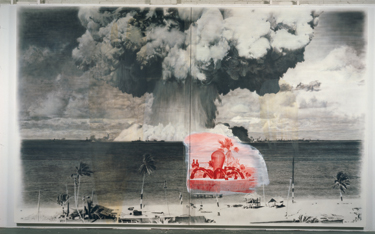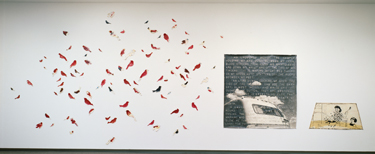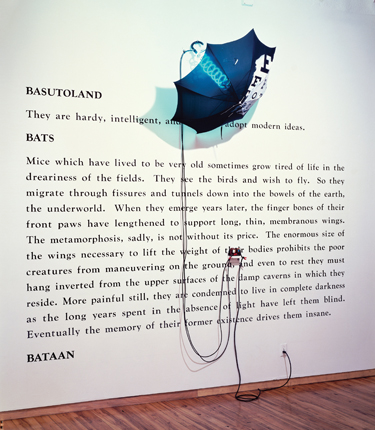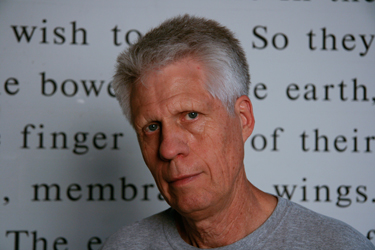Fort Worth artist Vernon Fisher figures he escaped the bland certainties of a traditional rural Texas life through a crack in the façade between Protestant denominations –– his mom was a Baptist and his father a Methodist. He emerged into a life of art and thinking that brought him, eventually, back to the images that he grew up with in North Texas — and that have now landed him at the Modern Art Museum of Fort Worth in the museum’s biggest show ever devoted to a Fort Worth artist.
 Fisher’s fascination with the vernacular of his Cold War youth takes many forms. He’s created paintings that look like blackboards, full of trompe l’oeil marks and smudges, and he has referenced Mickey Mouse, Nancy and Sluggo, Robert Mitchum, and King Kong, among many other pieces of iconic Cold War-era imagery. The title of his Modern show, K-Mart Conceptualism, is a nod to America’s first super-repository of the vernacular. (Modern curator Michael Auping recently noted that he’d been asked –– more than once –– whether K-Mart in some way funded the show, culled from private and public collections in the United States and Europe. The store did not.) Fisher’s work also involves text, mainly short fiction, no doubt a byproduct of the artist’s beginnings as an aesthete –– he was a literature major in college before falling in love with painting and switching majors.
Fisher’s fascination with the vernacular of his Cold War youth takes many forms. He’s created paintings that look like blackboards, full of trompe l’oeil marks and smudges, and he has referenced Mickey Mouse, Nancy and Sluggo, Robert Mitchum, and King Kong, among many other pieces of iconic Cold War-era imagery. The title of his Modern show, K-Mart Conceptualism, is a nod to America’s first super-repository of the vernacular. (Modern curator Michael Auping recently noted that he’d been asked –– more than once –– whether K-Mart in some way funded the show, culled from private and public collections in the United States and Europe. The store did not.) Fisher’s work also involves text, mainly short fiction, no doubt a byproduct of the artist’s beginnings as an aesthete –– he was a literature major in college before falling in love with painting and switching majors.
“I’ve devoted most of the second floor of the museum to Vernon’s show, which is what I have done for almost all of the major artists we’ve shown,” Auping said. “I didn’t think Vernon should be treated any less.”
Auping, who put together a Fisher retrospective several years ago while working at the Albright-Knox Art Gallery in Buffalo, N.Y., had wanted to exhibit Fisher’s work at the Modern for some time but “had to put it off, probably because he is in my own backyard.” K-Mart Conceptualism fortuitously coincides with a Fisher monograph recently published by the University of Texas Press. “The exhibition [then] seemed like the perfect thing to do,” Auping said.
Fisher grew up in Granbury. “In some ways I had an idyllic childhood … So that kind of background always gives you a touchstone for certain kinds of reverie, I think, especially if you’re not a loner exactly but you do spend a lot of time by yourself … and that becomes something that you return to, and I think you see it in the work.”
 His mother stayed at home, and his father was a traveling salesman. Art was anathema to the young Fisher. “I tried to be a very normal kid,” he said. “I think part of that was that my sister was kind of borderline mentally handicapped. In those days, there was a stigma attached to that, so you tried your best to be like everybody else, try your best to be normal. But in small-town Texas, there’ll be 60 people in your class, and you’ll know everybody. I’m talking 200 people in high school. There’s a lot of pressure to fit in, and you really don’t have that many choices, so I did what a lot of guys did. I went out for all the sports. I played football and ran track, did basketball, the whole thing.”
His mother stayed at home, and his father was a traveling salesman. Art was anathema to the young Fisher. “I tried to be a very normal kid,” he said. “I think part of that was that my sister was kind of borderline mentally handicapped. In those days, there was a stigma attached to that, so you tried your best to be like everybody else, try your best to be normal. But in small-town Texas, there’ll be 60 people in your class, and you’ll know everybody. I’m talking 200 people in high school. There’s a lot of pressure to fit in, and you really don’t have that many choices, so I did what a lot of guys did. I went out for all the sports. I played football and ran track, did basketball, the whole thing.”
Art was “not in the picture,” he said. However, he must have had some interest in the visual arts. He always volunteered to do posters for school events. But during his senior year in college in Abilene, he realized he wanted to take painting as far as he could. He was within three hours of graduating with a lit degree when he switched tracks, which meant that he had to go another full year.
“It was cool in a lot of ways,” he said. “Where most people in college situations are juggling their art classes with their other classes, I had finished all those things, so I was acting like an artist. … [The professors] were kind enough to let me take the courses and leave me alone, which was cool to me.”
Transitioning from literature to art was rather easy, said Fisher, who started out as a math major. “I took a literature course in high school. I stumbled on this [Modernist] poem, [T.S. Eliot’s] ‘The Love Song of J. Alfred Prufrock.’ I said, ‘Oh, my god.’ I got it. I understood it. Not everybody did, but it really spoke to me, and I said, ‘You know, this is really interesting.’ ”
 After that, he said, he thought, “Maybe I’ll have literature as a minor, so I went through that whole transition: math major, literature minor; literature major, math minor; literature major, history minor. Literature was pretty close. Once you’re into aesthetics, once you’re really dealing with an aesthetic experience, then it’s not that big a jump from there to art. But once I got into art, I was, like, nuts. It’s all I wanted to do. I was crazy for it.”
After that, he said, he thought, “Maybe I’ll have literature as a minor, so I went through that whole transition: math major, literature minor; literature major, math minor; literature major, history minor. Literature was pretty close. Once you’re into aesthetics, once you’re really dealing with an aesthetic experience, then it’s not that big a jump from there to art. But once I got into art, I was, like, nuts. It’s all I wanted to do. I was crazy for it.”
The jump also has made him into an artist who is perhaps more at home than most in putting his creative process into words.
Instead of starting out as a representational artist and expanding into abstraction, Fisher moved immediately into abstraction, inspired by Jasper Johns and Robert Rauschenberg, his immediate predecessors. A moment of serendipity heightened his abstractionist bent.
“I was listening to Wagner, the Siegfried funeral march, I think, and I was looking through an art appreciation book, and I stumbled on the painting by Franz Kline that had the exact same title,” Fisher recalled. “And I looked at that reproduction of that painting, and I was listening to this music, and I was going, ‘Oh, my god. This feels like that feels. This looks like that sounds.’ And a light bulb goes off, and then once you have that entryway, a door opens, and you’re set, and I just totally got into it.”
Fisher graduated, started a family, and won a fellowship with no strings attached to the University of Illinois. Though his undergraduate degree had been paid for by his father and Fisher had had his share of summer jobs, the scholarship marked a point in the burgeoning artist’s career in which he was essentially being paid to paint. The money wasn’t spectacular, but it was enough to support his family.
“The summer before, I was working for the city of Abilene on a water-sprinkler crew,” Fisher recalled. “You see three guys out in the field all the time, and one guy’s in the hole and the other two guys are watching? Well, I was the guy in the hole, and so I was making 50 bucks a week. When I left that job to go to graduate school, I basically got a raise, and all I had to do was paint.
“It was an incredible thing,” Fisher continued. “I had to do nothing for them at all. No teaching. Nothing. They just sent me this money. Plus, I had the whole health care [insurance] and that kind of thing. It was fabulous. It wasn’t quite enough to live on, but I was fortunate enough to sell a few paintings as a graduate student. I would enter these shows and would win these prizes. That and the university fellowship were enough. I came out of graduate school completely free of debt. I was really lucky, and I don’t know if that kind of situation even exists today.”
 Though his entrance into graduate school was based on his abstract-expressionist work, he spent his time in grad school on other, less ab-ex work. “I was casting around, looking for something to do that was interesting,” he said, “and I’ve always had a feeling for, for lack of a better word, the sublime, the notion that you can look at something that’s temporal and read into it things that are extra-temporal, that are transcendent in some way.”
Though his entrance into graduate school was based on his abstract-expressionist work, he spent his time in grad school on other, less ab-ex work. “I was casting around, looking for something to do that was interesting,” he said, “and I’ve always had a feeling for, for lack of a better word, the sublime, the notion that you can look at something that’s temporal and read into it things that are extra-temporal, that are transcendent in some way.”
Fisher began painting concentric circles that were soft and pulsating like the color junctures in Mark Rothko’s paintings. The circles were successful and occupied him through graduation.
After graduation, he got a part-time teaching job at Austin College in Sherman, where Fisher says his career really started –– he was selling paintings, and his work was appearing in museums. He was a long way away from installing sprinkler systems and selling Bibles in the South (another odd job that he had).
His nine years at Austin College amounted to a transitional period for his art. “It looks like, in retrospect, that I was looking for a bigger container, and I went through a series of stylistic changes,” he said. “But if there was anything in common [among] them, it was that I was looking for something that would hold all the things that I wanted to do.
 “The circles did one thing that I wanted to do, which was address the sublime, that notion of transcendence,” he said, “but it couldn’t deal with the quotidian, what it’s like to wake up in the morning, and you’re still sleepy, and the sun’s coming through the window, what it feels like to be at work, and what a joke is like, and what’s funny, you know, irony and deadpan, just a whole lot of things that I like to play with that are literary conceits, really.”
“The circles did one thing that I wanted to do, which was address the sublime, that notion of transcendence,” he said, “but it couldn’t deal with the quotidian, what it’s like to wake up in the morning, and you’re still sleepy, and the sun’s coming through the window, what it feels like to be at work, and what a joke is like, and what’s funny, you know, irony and deadpan, just a whole lot of things that I like to play with that are literary conceits, really.”
Abstract painting did not allow Fisher to explore such conceits. “I needed something. I didn’t know. I intuited. I didn’t even intuit. I just did it. I just let the work develop, and I didn’t say no to myself too many times,” he said.
His artistic restlessness manifested itself in handmade one-of-a-kind books, which led to his monumental pieces involving entire texts of short fiction. He only occasionally wrote stories for artworks.
“I typically wrote the stories separately from any collection of images,” he said. “I wrote stories, and I collected stories in a pile, so I’ve got a pile of stories, and they’re all in different states of revision. And then I’ve got a collection of images, chosen not to go with the stories necessarily but just because I like them, because you need a whole pile of images to choose from. And then I would try to connect them up some way.”
K-Mart Conceptualism contains several text pieces, including “Basutoland,” a fable about bats, and “The Coriolis Effect,” about yearning for a watery respite from the heat.
Fisher has most recently been occupied by a 1930s-era map of Africa, on which many of the countries are still under colonial rule. “There’s something about that that interested me, the notion of Africa as we saw it at that time as sort of a psychological projection of a darker side,” he said.
“If you grew up when I did, Africa was known as the dark continent. Of course, they had had advanced cultures at various times. And this is maybe an example of a racism that pervaded the whole country at that time and probably maybe still does,” he said. “Edward Said calls it Orientalism. It’s the Other. It’s mysterious. And so because you don’t know it, you attribute all these characteristics to it, and a lot of characteristics that we attribute to it from this culture and in Hollywood were things that I think would be more appropriately located in what Jung called the shadow. In other words, we can’t acknowledge our own shadow, so we project it onto a whole continent. And you see it in Tarzan movies. … Rather than acknowledging that we have that side, we project it out to another culture.”
Fisher is quick to point out that he’s not a political artist. “I hate to even talk about it as issues, because I don’t see these as a political thing as much as I do a reflection of my own interiority from the world I grew up in and how we saw things,” he said.
“The world I came from is reasonably rigid and religious. Everybody in town is Baptist, Methodist, Church of Christ, that sort of thing,” Fisher continued. “And the worldview is pretty homogeneous, and it’s still at a moment in non-urban culture where one could speak with authority on what everyone believes. You didn’t have to have any kind of caveats when you said something about the nature of reality, because everybody just sort of understood that this is the way reality is: God made the world and so forth. And what human nature was like was fixed and understood and what people were like and how they interacted and what was thought to be proper or improper, right or wrong, all that stuff, all that was a fixed universe.
“I hate to use words like ‘deconstruction,’ but in a way I think these paintings are interrogating this whole notion of that universe by using that universe against itself,” he said, “like how Hollywood sees that or how popular culture reflects that sort of absolutistic, inflexible, rigid self-righteousness. I’m making it more pejorative than I really mean to, because we were all complicit in it.”
And while Mickey Mouse, Nancy and Sluggo, and Robert Mitchum make appearances in Fisher’s work, he’s also quick to mention that he’s not a pop artist. “I’m only interested in pop culture from a certain period,” he said. “I’m not a pop artist. I’m not interested in making comments about the nature of our mercantile culture. I’m not like Warhol, who wants to drag low into high and make a point about both low and high.”
![“The Coriolis Effect” (1987) is another of Fisher’s flash-fiction pieces. “I started making little artist’s books, and since they were books, they were all abstract at first, and then they became representational,” Fisher said. “The nature of a book is that it’s very sequential. … Inevitably, if you’re going to make books, you’re going to make texts. … [Then] the texts developed into full-blown stories.” feat_5](https://www.fwweekly.com/wp-content/images/stories/images/10-27-2010/feat_5.jpg) What he’s most interested in, he said, is a particular period’s pop culture, that of his youth, and “how there are underlying assumptions and feelings associated with that that are part of my own makeup. So it’s kind of an interrogation of myself in a way. Why do I think like I do? Why do I feel like I do? Why does this interest me?”
What he’s most interested in, he said, is a particular period’s pop culture, that of his youth, and “how there are underlying assumptions and feelings associated with that that are part of my own makeup. So it’s kind of an interrogation of myself in a way. Why do I think like I do? Why do I feel like I do? Why does this interest me?”
Looking back, he said, his agenda “had something to do with my narrow escape from that world, that non-urban kind of world where everything is in its place and everyone sort of understands their place in that world, and I escaped through that crack in the cosmic egg. The key for me was that my mom was a Baptist, and my dad was a Methodist, and they couldn’t both be right. And that was the crack that I got out of. That’s the thing about absolutes is that you only have to find one exception, and then the whole thing collapses.”
Fisher also was out to confound expectations of what a painting should be. The art that had come before him was hyper-flat. His photorealist excursions, mainly his signature blackboard paintings, were excellent vehicles for flipping the script on traditional notions of contemporary art.
“Every representational mode brings with it its own set of expectations,” he said. “If you read a text, you have expectations. And if you see a text in the midst of these other things, these other elements –– allusion, depiction, and object –– very often it’s the text that has the most authority, at least in Western culture. You think that the text is where you’re going to look for the quote-meaning-unquote. Then you find as you interrogate the piece, these things don’t add up quite like you think, and so what you end up with is one interpretation after another. In other words, you can say, ‘Well, it could be this way’ or ‘Well, it could be this way’ or ‘It makes sense that it’s this way,’ and you get this kind of rippling [wave] of interpretation, which is what I like, because then you have an extended conversation with the painting.
 “Well, with a blackboard, you can have a lot of that compressed in a way, because a blackboard, especially the big ones, present themselves as objects,” he continued. “If you’ve seen the size of some of them, it’s this big, heavy, obdurate presence, but then there are all these representational or notational marks on it, which takes your mind in a different direction, and, what’s more, the marks look like they’re vulnerable to erasure. So on the one hand, you’ve got something that’s timeless and obdurate, and then you have these other things that are very vulnerable to being lost, so you have fragility and solidity, and you know it’s kind of a potent mixture to have in one piece. So that’s why I like those blackboards.”
“Well, with a blackboard, you can have a lot of that compressed in a way, because a blackboard, especially the big ones, present themselves as objects,” he continued. “If you’ve seen the size of some of them, it’s this big, heavy, obdurate presence, but then there are all these representational or notational marks on it, which takes your mind in a different direction, and, what’s more, the marks look like they’re vulnerable to erasure. So on the one hand, you’ve got something that’s timeless and obdurate, and then you have these other things that are very vulnerable to being lost, so you have fragility and solidity, and you know it’s kind of a potent mixture to have in one piece. So that’s why I like those blackboards.”
A master draftsman and conceptualist, Fisher feels his way into his paintings. “When I make a piece, I don’t think much of anything,” he said. “What I do is find things that I like. … Say I was going to make a blackboard and then I found a map. ‘Oh, what if I make a blackboard map, combine those things?’ And it’s just one what-if after another. At the time you’re making it, it all feels very arbitrary. There’s nothing pre-planned. There’s no agenda. I don’t know what the painting’s going to mean when I start out. I don’t even know if the painting’s going to be a success when I start out. But one thing leads to another.”
As part of the exhibit, art appreciators are invited to contribute their own stories inspired by Fisher’s work to the Modern’s K-Mart Conceptualism web site. Choice submissions will be published online and, after the exhibit closes, in a bound volume. The name of the project is Navigating by the Stars, after a book of Fisher’s writings published in 1989 by Landfall Press.
Auping said the Modern show is very different from what he organized in Buffalo. “I wanted to do something very different with [the Modern] show, which was to do a survey but limit the number of works, so that each one took on more weight. It’s a very different kind of choosing. So even though a lot of space has been devoted, the number of works has been limited. It makes for a more concentrated experience.”
K-Mart Conceptualism runs through Jan. 2 at the Modern, 3200 Darnell St., FW. Tickets are $4-10. Call 817-738-9215.












